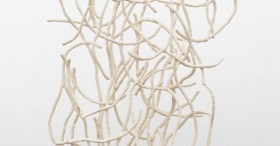Everybody has a dark side, a place of fear and dread they go to voluntarily or not. Managing that part of our lives is crucial to health and well-being, as COVID-19 has highlighted. However, it requires self-awareness, courage, and resilience to confront that aspect of your psyche.
The process of confronting the dark side is admittedly both painful and productive. Artists have always worked in that penumbral space, on the cusp between dark and light. For most their studio is a safe place when external pressures have the potential to overwhelm and where the dark side can be harnessed.
The World Health Organisation has reported, ‘that depression is expected to become the world’s second most burdensome disease by 2020.’
One in five Australians aged between 16-85 has also experienced some form of mental illness exacerbated by the isolation and dislocation caused by the COVID-19 pandemic.
Significantly, anxiety and depression have impacted Aboriginal communities with suicide the leading cause of death for Indigenous Children aged between five and 17.
However, while therapeutic and medical treatments are widely employed (sometimes with dangerous side effects) global research increasingly documents the beneficial impact of the arts in promoting mental health and well-being at an individual and societal level. An opportunity exists to radically impact on this spreading nightmare and artists provide an exemplary model of practical, structured engagement with their dark side.
This is currently explored in the exhibitions DARK SIDE across two spaces in Perth. It is part of the extended program, Frame of Mind: Mental health and the arts, presented by Edith Cowen University (ECU) in collaboration with the National Art School in Sydney.
Both NAS and ECU will present a symposium and panel discussions; there is a free downloadable publication, cross-state student collaborations, and a vlogcast series, which explore the mental health challenges faced by artists, and the ways artists engage with themes of mental health within their work. The program content will be livestreamed and posted online,

Carla Adams, Harrison (detail). Image courtesy the artist.
DEEPER DIVE INTO THE DARK SIDE
When offered the opportunity to undertake psychiatric counselling, the German poet Rainer Marie Rilke reputedly protested, saying, ‘Don’t take my devils away because my angels might flee too’.
He was aware that the dark side is a counterbalance in life and provides the richness and complexity that defines us as individual human beings.
This is not to underestimate the impact of severe mental illness or to suggest that the arts are a panacea, merely to stress the therapeutic benefit of engagement with the arts as a tool to nurture well-being.
As curator working with the artists in the DARK SIDE exhibition, they have all found ways of making sense of their world and marking out a space for themselves by confronting their fears and externalising them in artworks.
Their creative practice is a mechanism that allows internal narratives to unfold in the controlled environment of the studio. While so much else is under sway by external forces, the practice of art-making remains singularly the practitioner’s domain. The artist has ultimate and sole control over the outcome.
This security and grounded-ness enable them to share their insights, provide reassurance, and offer a safe space for their audience to confront the collective concerns of their communities.
For Sharyn Egan, the memory of being taken from her family ‘and treated like dogs’ was a catalyst for re-creating the small babies she and her friends make from sardine cans, scraps of fabric, gravel, and whatever else was on hand. Her creativity was both a way of making sense of the nightmare she was experiencing while simultaneously moving beyond and taking control.
The safe space that art-making provides is a solace and a coping mechanism. As Tarryn Gill explains, ‘I am inspired by Jung’s Active Imagination process – using making as a bridge between the conscious and unconscious … I carry this into the studio – meeting myself through art-making’.
The rhythm of making is part of this process. Art takes time, and Tarryn Gill’s work is laborious, absorbing and provides time to reflect productively.
Similarly, for Tyrown Waigana, his work, A nice place to hate yourself is about, ‘finding a place, you can forget about yourself and all your problems’.

Tyrown Waigana, A Nice Place to Hate Yourself (2021). Image courtesy the artist.
These artists believe that by making art, it is possible to engage fully with the world. Indeed, this is one of the most powerful motivating forces for many artists when embracing a career in the arts. The challenge is to establish a point of equilibrium.
COVID-19 has exacerbated many of these traumas. As Lyndall Adams, Nicola Kaye, Stephen Terry, and Marcella Polain have discovered, addressing them with a collective art project has enabled the creation of ‘concretised memory.’
Overwhelmed by the absurdity of life, we can feel disoriented and adrift. Rather than being subsumed by this sense of alarm, Anna Nazarri embraces the dark side as a, ‘world of otherworldly escape that provides a world of unimaginable exploration’.
The DARK SIDE exhibition explores how these artists use their creative practice as a mechanism to comprehend their world. Through the experience of making art, they confront their fears and give external visual form to their existential musings.
DARK SIDE is showing at Gallery25, Edith Cowen University Campus Mt Lawley and at There-is in Northbridge, WA from 27 May — 17 June.
The symposium, Making Sense of the World Through Art, will be held Friday 11 June from 10.15am–5pm at Edith Cowan University and online. FREE to attend but bookings essential.
Keynote by Hiromi Tango and Panel Discussion: National Art School Cell Block Theatre, 19 June, 1.30–4pm. Register.
View the full Frame of Minds program.





